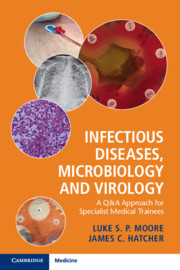Book contents
- Infectious Diseases, Microbiology and Virology
- Infectious Diseases, Microbiology and Virology
- Copyright page
- Contents
- Preface
- Reference Ranges
- Abbreviations
- Chapter 1 Biology of Bacteria, Viruses, Fungi and Parasites and the Host–Pathogen Interactions
- Chapter 2 Microbiology and Virology Laboratory Practice
- Chapter 3 Health and Safety for Infectious Diseases, Microbiology and Virology
- Chapter 4 Principles of Public Health in Relation to Infectious Diseases, Microbiology and Virology
- Chapter 5 Infection Prevention and Control
- Chapter 6 Important Clinical Syndromes Presenting from the Community and within Healthcare Organisations
- Chapter 7 Understanding the Use of Antimicrobial Agents
- Chapter 8 Vaccination
- Chapter 9 The Management of HIV Infection, Opportunistic Infections and Complications of Other Causes of Immunocompromise
- Chapter 10 Travel and Geographical Health; Imported Infection and the Provision of Pre-travel Health Advice
- Index
- References
Chapter 7 - Understanding the Use of Antimicrobial Agents
Published online by Cambridge University Press: 19 December 2019
- Infectious Diseases, Microbiology and Virology
- Infectious Diseases, Microbiology and Virology
- Copyright page
- Contents
- Preface
- Reference Ranges
- Abbreviations
- Chapter 1 Biology of Bacteria, Viruses, Fungi and Parasites and the Host–Pathogen Interactions
- Chapter 2 Microbiology and Virology Laboratory Practice
- Chapter 3 Health and Safety for Infectious Diseases, Microbiology and Virology
- Chapter 4 Principles of Public Health in Relation to Infectious Diseases, Microbiology and Virology
- Chapter 5 Infection Prevention and Control
- Chapter 6 Important Clinical Syndromes Presenting from the Community and within Healthcare Organisations
- Chapter 7 Understanding the Use of Antimicrobial Agents
- Chapter 8 Vaccination
- Chapter 9 The Management of HIV Infection, Opportunistic Infections and Complications of Other Causes of Immunocompromise
- Chapter 10 Travel and Geographical Health; Imported Infection and the Provision of Pre-travel Health Advice
- Index
- References
Summary
A basic understanding of the mechanism of action and indication for antimicrobials is held by most prescribers. The key properties of different classes of antimicrobials, their anticipated side effects and the spectrum of activity against different pathogens is inherent in most undergraduate and post-graduate medical curricula. Practitioners in the fields of infectious diseases, microbiology and virology must have a firm grasp of this knowledge, and should be able to apply it to patients with bacterial, viral, fungal or parasitic infections. They must be able to integrate this knowledge with the pharmacokinetic properties of the antimicrobials, and should be able to adapt this in differing patient populations including those with renal impairment or on renal replacement therapy and those with allergies or other host factors.
- Type
- Chapter
- Information
- Infectious Diseases, Microbiology and VirologyA Q&A Approach for Specialist Medical Trainees, pp. 154 - 178Publisher: Cambridge University PressPrint publication year: 2019

